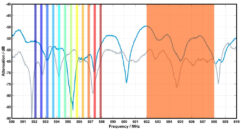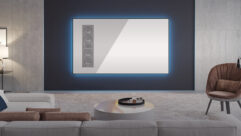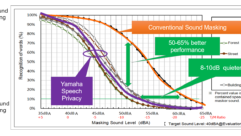The Sound of Silence
Jan 1, 2003 12:00 PM,
Stefan Carmien
Buddhism first came to the United States in the late 19th century, but only in the past 30 years has there been a relative explosion of American Buddhist groups. Most American Buddhist communities are composed of immigrants from Asian countries where the faith has been established for many centuries. The growth of Buddhism in the United States has lead to the building and adapting of facilities for Buddhist services.
A building dedicated for use by a Buddhist community has some similar A/V requirements to more mainstream congregations and also some distinct needs. Like its Jewish, Christian, and Islamic counterparts, a Buddhist shrine room needs to provide amplification for lectures, sermons, and dharma talks (Buddhist teachings) as well as the ability to support presentations of audio and video material. Buddhist centers record events for dissemination, and like other small congregations, they require a “hands-off” system that will handle most events without a skilled operator. Buddhist centers tend to be rich in vision but poor in resources, both cash and skills.
The United States has hundreds of Buddhist urban centers and many retreat centers based on Japanese, Southeast Asian, and Tibetan traditions. I have been providing A/V technical support for Buddhist centers in North America for 28 years. This article will describe the installations at two such centers, which will serve as good examples of what you might expect to find in other communities. The Boulder Shambhala Center — in Boulder, Colorado — boasts 600 members and serves an outlying community of perhaps 800 people. The rural Shambhala Mountain Retreat center is located on 400 acres near Red Feather Lakes, Colorado, and has year-round events ranging in size from 30 to 500 participants.
However, these spaces have different requirements. Because Buddhist practice primarily consists of silent meditation (in contrast to group liturgy, praying, and singing hymns), the noise floor of the sound system has to be low enough so that the best hearing in a room of 300 meditators cannot detect any background noise. It also has to provide enough gain for teachers coming from cultures that do not use microphones (which often means poor mic technique). Additionally, many of the visiting teachers do not speak English well, and thus they require a translator. Some teaching situations bring in enough foreign monolingual students to require translation services.
WORSHIP SERVICES
Three kinds of events typically require the shrine room sound system. The most common is daily meditation practice. The practice is lead by a person, called the umedze, who sits next to the shrine box. The umedze leads the opening chants, times the practice, and in longer sessions, indicates the change of practice (for example, sitting to walking meditation) and leads the closing chants. The opening and closing chants are often accompanied by percussive instruments (drums and bells), so the channel used by the chant leader should have a compressor/limiter in the signal chain.
The hall can also be used as a lecture hall for dharma talks. This setup usually entails a chant leader for the opening liturgy, a mic for the teacher, and one or several microphones for questions. Sometimes a translator accompanies the teacher; in this instance, you would need an operator at the mixing console, or an automatic mic mixer could be used to ensure that only the microphones being used are gated to reduce feedback. If the talk is videotaped, an audio feed is necessary for the video soundtrack, and the audience will need a mic for questions.
Finally, the hall may be used for all sorts of other events. Some community celebrations require amplification of musical instruments. In retreat centers, during the one-to-three-month-long retreats, all meals are eaten in the shrine room in a meditative style called orioki. In this case, the chant leader needs a well-positioned microphone for leading long, involved chants during the dining ritual. Weddings and funerals are also held in the shrine hall, requiring a chant leader, a preceptor (usually a teacher), and one or two mics set up for the reading of poetry or other contributions from those in attendance.
URBAN CENTER
The urban center is located in a three-story converted office building in downtown Boulder. The third floor is the main shrine room, and several smaller shrine rooms are located on the second floor and in the basement. In addition, the common spaces include a small family center/child-care room and a community parlor. The main shrine room and a smaller shambhala shrine room on the second floor provide space for group meditation, dharma talks, and ongoing classes. Both of the spaces were served by the typical mixer/EQ/amp systems that are often found in small churches.
The shrine rooms had simple powered mixers driving small flown speakers. The sound quality was minimal, and even small differences in setup often resulted in awful sound, big frustration by the users, and frequent visits by the sound tech. The center decided to create a transparent, flexible system with better sound quality.
In specifying the requirements, the most important item was that the system be operator-free. It had to be transparently flexible, accommodating changes with no need for expertise. The goal was to have the system automatically work for 95 percent of the events. The system had to provide overflow crowds with clear, highly intelligible sound (this is important, given that many of the unfamiliar terms used in lectures are Sanskrit, Pali, and Tibetan technical Buddhist terms). Finally, it had to flexibly accommodate changing needs.
The design for the main shrine room featured an automatic mic mixer. The mixer accommodated four microphone channels, a CD player, a cassette deck, a wallmounted aux input (for use when an audio track was necessary while showing a video), and a telephone interface. The automatic mic mixer’s compressor/limiter and a feedback eliminator provided sufficient signal processing to allow the full gain potential of the system while ensuring proper unattended system behavior.
Amplification for two main speaker systems and a smaller system for audience fill at the far (entrance) end of the main shrine hall was enough to cover the room, along with a subwoofer driven by a separate amp behind the teaching throne. A balanced output for videotaping talks and a balanced line-level feed to the other larger shrine room on the second floor were also a part of the design specification. A 70V constant voltage system feeds to the first-floor community parlor and the basement family center, and provisions were made for installing coax feeds to all the other spaces for videotaping of events. A telephone hybrid allows for conference calls with other centers.
The only user-accessible controls on the system are an on/off switch and gain controls for the various input devices. For more complicated events that require more hands-on control and more microphones, the center uses an ancillary mixing board and patches it into the system through the video/aux feed. The result, after several years of tweaking, is a high level of satisfaction with the system and a virtual elimination of emergency calls to the technician.
A similar scaled-down version was installed in the smaller shambhala shrine room (automatic mic mixer and antifeedback device). Inputs include CD, cassette, video/aux input, balanced line-level feed, and coax from the main shrine room above. The shrine room is often used for community receptions and for spillover from events in the main shrine room. Video and audio is fed from the main shrine room into a monitor.
RETREAT CENTER
The rural retreat centers provide similar design requirements, with added need for more flexibility, as the spaces are used for other traditions, as well. The Shambhala Mountain Retreat center had three sets of requirements for its spaces — the Sacred Studies hall, a portable P.A. for the summer programs tent, and the Great Stupa of Dharmakaya.
The 400-acre facility has gone through many changes over the years, first being used as a rugged solitary retreat facility, then as a small group retreat center, and now as a center supporting large summer retreat programs (more than 400 participants and staff) and for midsize group retreats (10 to 80 people) year-round. The large retreats are held in a big tent with the sound system mounted in a wheeled rack that is put out in spring and stored during the winter. The smaller programs are held in the Sacred Studies hall or in the Great Stupa of Dharmakaya.
For many years, a three-month summer program was held in a smaller tent, with a shrine/lecture platform on one side and a table for the sound system and video equipment on the other. Between 100 and 300 people would sit on meditation cushions and hear lectures or do meditation practice during the retreats.
That presented several problems. The equipment was exposed to the elements, and a technician needed to operate the system, which created staffing problems. The annual setup and teardown also caused accelerated wear of the equipment. The solution was to use the same form factor as before with an automatic mic mixer and a feedback eliminator and to use a more portable and robust speaker system designed for outdoor use and a more portable rack system to protect the equipment. The system became simple and reliable enough for unskilled staff to operate, and the annual spring/winter install/breakdown became just unloading the rack, plugging it in, and connecting the speaker system and the mics into an audio snake.
Designed for multiple uses, the hall can be divided into three practice or lecture halls, each needing a combinable A/V system. The mic, speaker, network cables, and wall connectors were preinstalled rather than having to retrofit them like the urban spaces. That allowed the staff to work with the architect to ensure the A/V systems integrated well with the buildings’ intended uses.
There are three possible spaces, but at any one time, there are only two events requiring sound-system support. The initial design and install specified two automatic mic mixers, antifeedback devices, and custom control circuitry, which let the spaces be served independently and in various combinations. However, the system was flexible but too difficult to operate to the satisfaction of the users. A redesign of the control circuitry, making it simpler but less flexible, resulted in a system that was easier to operate and thus more used.
A DESIGN CHALLENGE
A remarkable structure, the Great Stupa of Dharmakaya was built by volunteers during a 13-year period at the cost of several million dollars. The stupa stands 108 feet high and contains three levels. A 48-square-foot base with gates, stairways, and openings on all four sides forms the lower level. The assembly hall inside is 33 feet square and 24 feet high. In the center is a large golden statue of the Buddha sculpted in the Gandaran style.
Most stupas are sealed monuments, but the Great Stupa of Dharmakaya’s Hall of the Buddha is open to the public. Although primarily a pilgrimage site, it also accommodates practice and teaching and is an increasingly popular spot of local tourism. The hall’s sound reinforcement had to be completely transparent and rugged, and it had to last for many years. In addition, replacing the external system elements had to be a nontrivial task, because the surfaces are highly ornamented. The speaker systems needed to be unobtrusive, and the electronics had to be reliable and capable of running completely unattended, not needing replacement for many years.
The initial design work has been done, and the first level’s in-wall speakers are installed, but fund-raising is needed for the final install. Fortunately, the builders realized early in the construction the need for low-voltage systems of many sorts (including A/V needs) and thus built in plenty of conduit for the final install. Automatic mic mixers and antifeedback devices will be used for each floor (located on a rack in the base of the building), with a multichannel amp driving all floors. For playback of incidental music, guided tour narration, and the recording of teachings, multiple CD recorders are employed and centrally rackmounted. The system on each floor will be controlled by custom-designed control electronics and the remote-control devices shipped with the CD recorders.
RULES OF THUMB
Decades of working as the volunteer in-house contractor and operator for this relatively small but international community has taught me some general rules.
Be clear about the design in a given situation
As a professional, you know best how to reach the desired solutions, but don’t risk alienating the staff by giving them choices that they aren’t capable of making a decision upon. That can be difficult with people who are not familiar with audio and video systems, so you might find yourself in the role of a teacher.
You are an educator
One of your responsibilities is to raise the expectations of what the A/V environment can be and then to live up to them in your design and execution.
Plan early
Just like any kind of install, plan early and control the time involved with implementing it. Nothing is more frustrating than being forced to provide an awkward and unworkable solution because the needs of the congregation and the installation were not discussed early in the planning stages. Remember to listen carefully to the customer’s complaints and concerns.
Think big
Think about what might be needed five years from now so that you can expand your design instead of installing a new system that might not be financially feasible.
Handle mic training issues
Those who give sermons, lectures, and dharma talks have varying degrees of performance skills. Don’t hesitate to suggest training sessions to the members who use the sound system. In fact, you could provide that training as part of the system quote.
Designing and installing audio and video systems for Buddhist communities can be demanding and rewarding. The most interesting part of this design challenge is creating high-tech solutions that transparently adapt and accommodate day-to-day use by nontechnical people.
Stefan Carmien has been active in audio work for 35 years and is a researcher at the University of Colorado in developing cognitive prosthetics for individuals with cognitive disabilities. He can be reached at [email protected]. Thanks to the staff at Ford Audio in Denver for assistance with this article.










